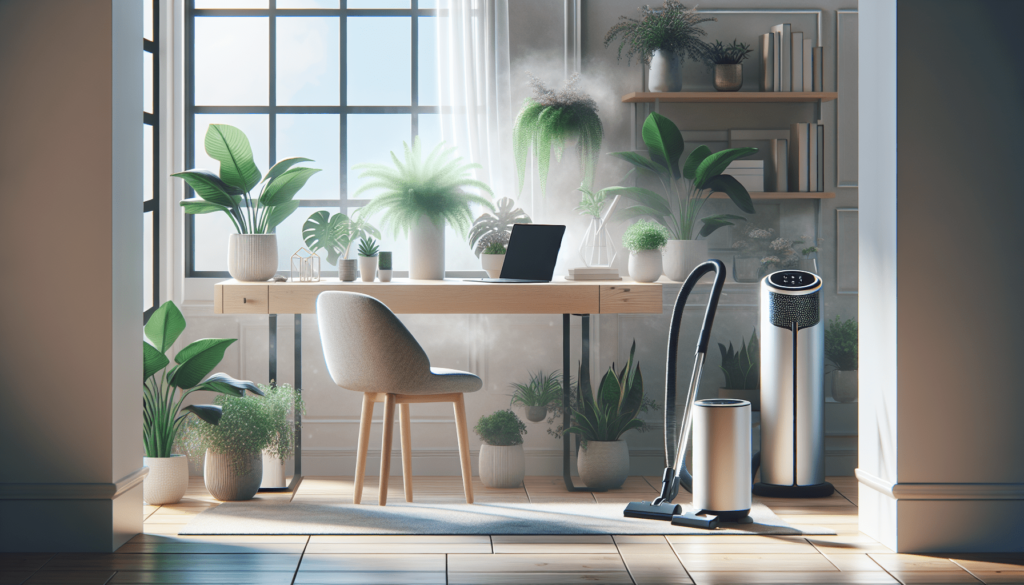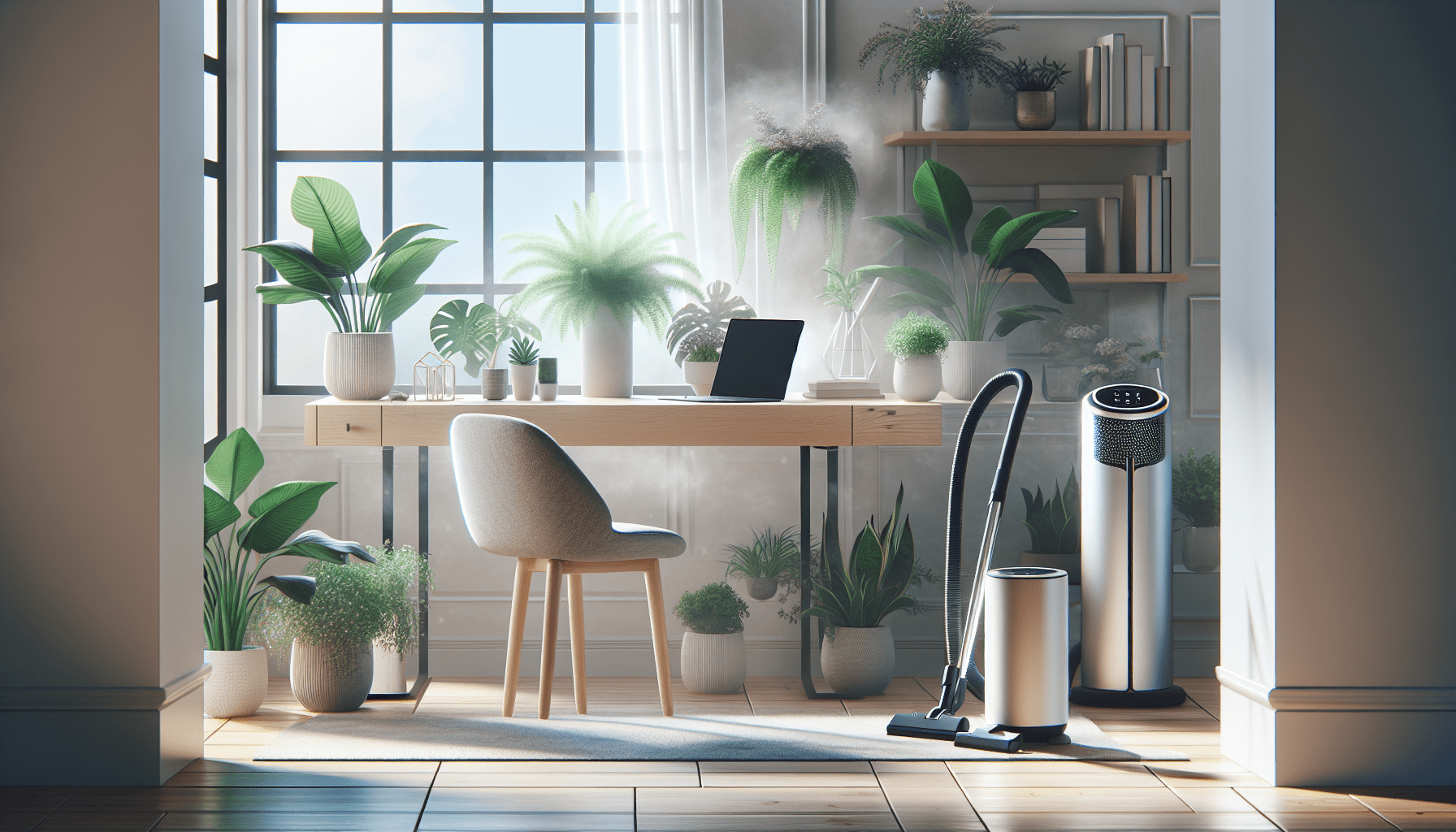Have you been sneezing, wheezing, or dealing with itchy eyes more frequently while working from home? If so, you’re not alone. Many people are discovering that their homes, where they spend more time than ever, can be full of allergens that make the workday miserable. Luckily, there are ways to reduce allergens in your home office to create a more comfortable and healthier work environment.

Why Reducing Allergens is Important
Reducing allergens is essential because prolonged exposure can significantly impact your physical health and overall productivity. Allergens can lead to allergies and respiratory issues, including asthma, which makes focusing on work tasks difficult. Additionally, mitigating allergens can contribute to a cleaner and more pleasant living environment.
Tip 1: Regular Cleaning
Cleaning is the first line of defense against allergens. Dust, pet dander, pollen, and mold can accumulate quickly, especially in areas you might not frequently clean.
Daily Routine
Make a habit of cleaning surfaces you touch daily, such as your desk, keyboard, and mouse. Use a damp cloth rather than a dry one, as the latter can spread the allergens around.
Weekly Deep Clean
Set aside time each week to perform a deeper clean. Vacuum carpets, dust hard-to-reach areas, and sweep floors. Don’t forget about soft furnishings, which can trap allergens. Vacuum your upholstered furniture and launder any linens and curtains regularly.
Use the Right Cleaning Tools
Opt for HEPA-filter vacuums and microfiber cloths, which are designed to trap and hold onto allergens, preventing them from becoming airborne and resettling.
Tip 2: Optimize Air Quality
Air quality plays a crucial role in reducing allergens. Poor ventilation can cause allergens such as dust mites, mold spores, and pet dander to build up.
Air Purifiers
Invest in an air purifier with a HEPA filter for your home office. These devices can capture up to 99.97% of microscopic airborne allergens.
Ventilation
Ensure your workspace is well-ventilated. Open windows periodically to allow fresh air to circulate. However, if outdoor air quality is poor, keep windows closed and use your air purifier instead.
Houseplants
Certain houseplants can help improve indoor air quality by removing toxins. Plants like spider plants, peace lilies, and Boston ferns are particularly effective. Keep in mind that some people are allergic to pollen, so choose low-pollen plants.
Tip 3: Minimize Fabric Surfaces
Fabric surfaces, such as carpets, curtains, and upholstered furniture, can harbor significant amounts of allergens.
Flooring
Opt for hard flooring like wood, laminate, or tile for your home office. These materials are easier to clean and don’t trap allergens like carpets do.
Window Treatments
Choose blinds or shades instead of heavy drapes. Blinds and shades are easier to wipe down and don’t trap as many allergens as fabric curtains.
Furniture
Consider furniture with smooth surfaces like leather or vinyl as opposed to fabric upholstery. Again, it’s all about ease of cleaning and reducing places where allergens can hide.

Tip 4: Manage Humidity Levels
Humidity plays a significant role in the proliferation of allergens like mold and dust mites.
Dehumidifiers
Use a dehumidifier to keep indoor humidity levels below 50%. High levels of humidity can foster mold growth and increase dust mite populations.
Bathrooms and Kitchens
These areas are usually high in moisture. Make sure to use exhaust fans while cooking and after showering to help control humidity.
Regular Monitoring
Utilize a hygrometer to regularly check the indoor humidity levels. Proper monitoring can help you take timely action to manage humidity effectively.
Tip 5: Allergen-Proof Your Workspace
Taking specific steps to allergen-proof your workspace can go a long way in alleviating allergy symptoms.
Desk Setup
Use a desk that is easy to clean, such as one made of smooth wood or metal. Avoid clutter, as it can collect dust. Use organizers for your papers, office supplies, and gadgets to keep surfaces clear.
Monitor and Keyboard Covers
Soft, padded keyboard covers and washable monitor filters can help collect dust and allergens. Make sure to clean them regularly.
Storage Solutions
Store items in plastic bins with lids to keep dust and allergens out. Cardboard boxes can attract dust mites and are harder to clean.
Pets
If you have pets, keep them out of your workspace as much as possible. Pet dander is a common allergen that can worsen symptoms. However, if you must have them around, make sure to vacuum and clean your workspace more frequently.
Common Allergens and How to Combat Them
Understanding common allergens can help you focus your efforts more effectively. Here are some of the most common indoor allergens and how to mitigate them:
| Allergen | Description | Mitigation |
|---|---|---|
| Dust Mites | Tiny creatures that feed on dead skin cells. They thrive in bedding, upholstery, and carpets. | Use mite-proof covers, wash bedding weekly in hot water, reduce humidity, vacuum frequently. |
| Pet Dander | Tiny skin flakes shed by pets. Dander is sticky and can cling to fabric and other surfaces. | Keep pets out of certain rooms, bathe pets regularly, use HEPA filters. |
| Mold Spores | Microscopic fungi that grow in damp conditions. | Fix leaks, use dehumidifiers, clean bathrooms and kitchens regularly, ensure proper ventilation. |
| Pollen | Fine particles released by plants. | Keep windows closed during high pollen count, use air purifiers, clean air filters in HVAC systems. |
| Cockroach Droppings | Particles from cockroach feces can become airborne. | Keep food sealed, dispose of garbage regularly, use pest control measures. |
Easy-to-Implement Lifestyle Changes
Implementing small lifestyle changes can also help in reducing allergens in your home office.
Regular Hand Washing
Wash your hands frequently, especially after coming indoors or handling your pet. This simple step can prevent the transfer of allergens from your hands to other surfaces.
Change Clothes
If you’ve been outside, change into clean clothes before entering your home office. Pollen and other outdoor allergens can cling to your clothing and be transferred indoors.
No Shoes Indoors
Adopt a no-shoes policy indoors to keep dust, dirt, and pollen from being tracked inside. Use washable indoor slippers if needed.
Fresh Linens
Wash your bedding and any cloth materials in your office regularly. Use hot water to kill dust mites effectively.
Additional Considerations
Reducing allergens isn’t a one-time activity but an ongoing process. Stay aware and make adjustments based on changes in season, new furniture, or any other alterations in your living environment.
Regular Inspections
Inspect your home for mold growth, leaks, or any other conditions that might foster allergens. Early detection can prevent bigger problems down the line.
Seasonal Allergies
Be extra cautious during seasons when allergens like pollen are more prevalent. Close windows, use air purifiers, and consider using hypoallergenic covers.
Use Allergen-Proof Covers
Invest in allergen-proof covers for mattresses and pillows. These covers are designed to keep dust mites and other allergens at bay.
Professional Cleaning Services
If your home office generates a lot of dust or you’ve got a heavy workload with little time for cleaning, consider using professional cleaning services occasionally to perform deep cleaning.
Conclusion
Reducing allergens while working from home takes some effort but can lead to a much healthier and more enjoyable work environment. Regular cleaning, optimizing air quality, minimizing fabric surfaces, managing humidity levels, and taking specific steps to allergen-proof your workspace are all effective ways to reduce allergens. By understanding common allergens and implementing these practical tips, you can create a cleaner, more comfortable home office that allows you to focus better and breathe easier.
Remember, it’s all about making consistent, manageable changes. Small, routine tweaks can add up to a significant improvement over time. So, take a deep, allergen-free breath and get to work on creating a healthier home office today!
